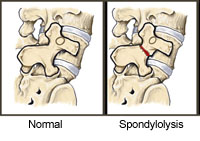Symptoms
- Lower back pain is most common symptom.
- Leg pain.
- Vague symptoms such as tightening of hamstrings and mild muscle spasms.
- Dimple at site of slippage.
- Local tenderness
Diagnosis
The diagnosis of spondylolisthesis is confirmed by noting the forward position of one vertebral body on another. In addition to a physical exam the below diagnostic tests may be ordered:
- X-ray
- Computed Tomography (CT) scan.
- Magnetic Resonance Imaging (MRI).
Spondylolisthesis is graded according to the amount that one vertebral body has slipped forward on another.
- Grade I: upper vertebra has slipped forward less than 25 percent of the total width of the vertebral body.
- Grade II: slip is between 25 and 50 percent.
- Grade III: slip between 50 and 75 percent.
- Grade IV slip is more than 75 percent.
- Grade V: the upper vertebral body has slid all the way forward off the front of the lower vertebral body, a condition called spondyloptosis.
Treatment
Most people without any signs of nerve compression or other neurologic impairment, the first line of treatment consists of non-surgical therapies such as medication, rest and physical therapy. Bracing and epidural spinal injections also may be recommended.
Spine surgery is typically considered only after conservative therapies fail to adequately relieve symptoms over a significant period of time, or if evidence of nerve involvement, such as numbness or tingling, muscle weakness or bowel or bladder impairment, develops.
Surgical procedures that may be recommended for the treatment of spondylolisthesis include:
The procedures are typically performed together as part of the same surgery, the overall goal of surgery is to stop the slippage, remove the source of irritation and inflammation and restore the stability of the spine.
The benefits of spine surgery, however, must be weighed against the risks. Discuss with your surgeon the risks and benefits of surgery, and the potential results of operative versus non-operative treatment.


